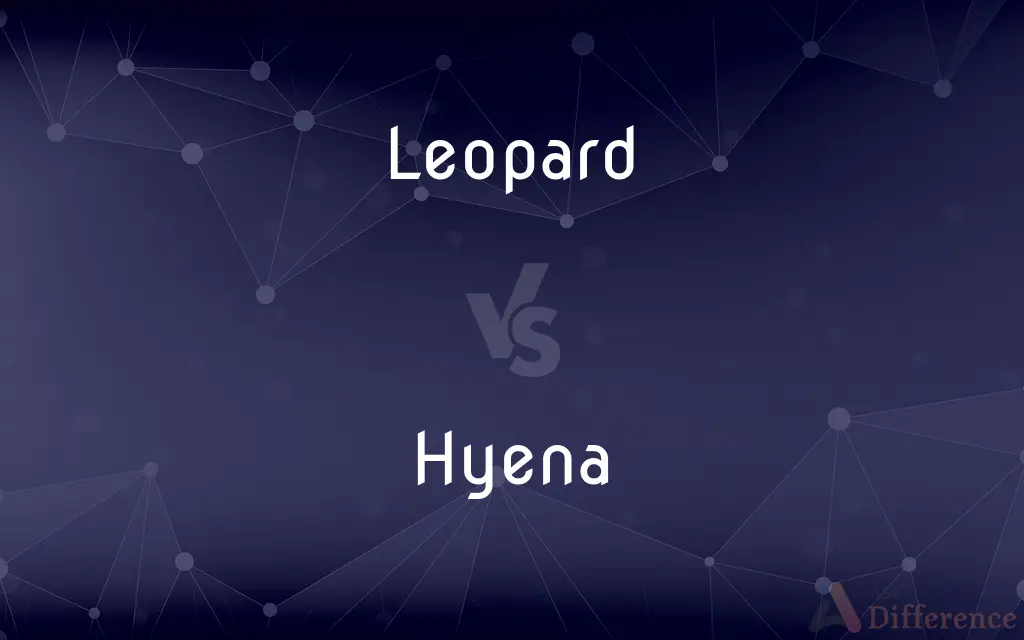Leopard vs. Hyena — What's the Difference?
By Fiza Rafique & Maham Liaqat — Updated on April 24, 2024
Leopards are solitary, agile big cats known for climbing abilities and strength in hauling prey up trees, whereas hyenas are social, primarily ground-dwelling animals known for their scavenging habits and strong jaws.

Difference Between Leopard and Hyena
Table of Contents
ADVERTISEMENT
Key Differences
Leopards are part of the Felidae family and are known for their stealth and power, characterized by their rosette-patterned coat which provides excellent camouflage in their natural habitat. Hyenas, on the other hand, belong to the Hyaenidae family and have a more rugged appearance with shorter hindquarters and a mane of tough hair.
Leopards excel in climbing and often use trees for resting and storing their prey away from other predators. Hyenas lack climbing abilities but compensate with their strong social structures, hunting in packs and using teamwork to overpower larger prey and defend themselves.
In terms of diet, leopards are versatile predators that hunt a variety of animals, relying heavily on the element of surprise. Hyenas are often thought of as scavengers but are also effective hunters; they are known for their endurance in chasing prey over long distances.
Leopards are generally solitary animals, with individuals maintaining large territories that they mark and defend against others. Hyenas contrast sharply in this aspect, as they live in large, complex social groups called clans, which can contain up to 80 individuals.
The vocalizations of leopards include growls, snarls, and purrs, primarily used for territory marking or signaling cubs. Hyenas are well-known for a wider range of sounds, including whoops, giggles, and groans, which play a crucial role in communication within their social groups.
ADVERTISEMENT
Comparison Chart
Family
Felidae
Hyaenidae
Social Structure
Solitary
Social, lives in clans
Hunting & Diet
Predatory, diverse diet
Both predatory and scavenging
Physical Adaptations
Climbing abilities, stealth
Strong jaws, endurance
Vocalizations
Growls, snarls, purrs
Whoops, giggles, groans
Compare with Definitions
Leopard
Prefers wooded or grassland habitats where it can camouflage and stalk prey.
The leopard uses its camouflaged coat to hide and ambush its prey.
Hyena
Lives in large, matriarchal groups called clans.
A hyena clan's social structure is complex and hierarchical.
Leopard
A large, carnivorous cat native to Africa and parts of Asia, known for its rosette-spotted coat.
A leopard can carry prey twice its weight up a tree.
Hyena
A mammal known for its scavenging behavior but also skilled in hunting.
Hyenas often scavenge meals but can hunt effectively in packs.
Leopard
Capable of adapting to various environments, including those impacted by human activity.
Leopards are sometimes spotted on the outskirts of urban areas.
Hyena
Found primarily in Africa, adapting well to both arid and forested areas.
Hyenas are versatile in their habitat preferences, thriving in varied environments.
Leopard
Noted for its strength and agility, often symbolizing stealth and ferocity in various cultures.
The leopard is a frequent subject in the folklore of the regions where it is found.
Hyena
Recognized by its distinctive bear-like gait and whooping calls.
The whooping call of a hyena can be heard several kilometers away.
Leopard
Solitary by nature, marking large territories to avoid competition.
A male leopard's territory can overlap with several females but rarely with another male.
Hyena
Exhibits high intelligence and social complexity among carnivores.
Hyenas use strategic teamwork to isolate and take down prey.
Leopard
The leopard (Panthera pardus) is one of the five extant species in the genus Panthera, a member of the cat family, Felidae. It occurs in a wide range in sub-Saharan Africa, in some parts of Western and Central Asia, Southern Russia, and on the Indian subcontinent to Southeast and East Asia.
Hyena
Hyenas, or hyaenas (from Ancient Greek ὕαινα, hýaina), are feliform carnivoran mammals of the family Hyaenidae . With only four extant species (in three genera), it is the fifth-smallest biological family in the Carnivora and one of the smallest in the class Mammalia.
Leopard
A large wild cat (Panthera pardus) of Africa and southern Asia, having either tawny fur with dark rosettelike markings or black fur.
Hyena
A doglike African mammal with forelimbs that are longer than the hindlimbs and an erect mane. Hyenas are noted as scavengers but most are also effective hunters.
Leopard
Any of several similar felines, such as the cheetah or the snow leopard.
Hyena
Any of several carnivorous mammals of the family Hyaenidae of Africa and Asia, which feed as scavengers and have powerful jaws, relatively short hind limbs, and coarse hair.
Leopard
(Heraldry) A lion in side view, having one forepaw raised and the head facing the observer.
Hyena
Any of the medium-sized to large feliform carnivores of the subfamily Hyaenidae, native to Africa and Asia and noted for the sound similar to laughter which they can make if excited.
Leopard
Panthera pardus, a large wild cat with a spotted coat native to Africa and Asia, especially the male of the species (in contrast to leopardess).
Hyena
Any carnivorous mammal of the family Hyænidæ, doglike nocturnal mammals of Africa and southern Asia, of which three living species are known. They are large and strong, but cowardly. They feed chiefly on carrion, and are nocturnal in their habits.
Leopard
(inexact) A similar-looking, large wild cat named after the leopard.
Hyena
Doglike nocturnal mammal of Africa and southern Asia that feeds chiefly on carrion
Leopard
The clouded leopard (Neofelis nebulosa), a large wild cat native to Asia.
Leopard
The snow leopard (Panthera uncia), a large wild cat native to Asia.
Leopard
(heraldry) A lion passant guardant.
Leopard
Any of various nymphalid butterflies of the genus Phalanta, having black markings on an orange base.
Leopard
A large, savage, carnivorous mammal (Felis leopardus). It is of a yellow or fawn color, with rings or roselike clusters of black spots along the back and sides. It is found in Southern Asia and Africa. By some the panther (Felis pardus) is regarded as a variety of leopard.
Leopard
The pelt of a leopard
Leopard
Large feline of African and Asian forests usually having a tawny coat with black spots
Common Curiosities
Can leopards and hyenas coexist in the same habitat?
Yes, leopards and hyenas can coexist in the same areas, but they often compete over food and territory, leading to conflicts.
How effective are hyenas in group hunting?
Hyenas are highly effective in group hunting, using coordination and numbers to take down larger prey and defend their kills.
What are the main threats to leopard populations?
The main threats to leopard populations include habitat loss, human-wildlife conflict, poaching for their skins, and depletion of their prey base.
How do hyenas establish social hierarchy within their clans?
Hyenas establish social hierarchy through complex interactions including vocal communication, body postures, and direct encounters, with females generally dominating males.
What challenges do leopards face when sharing territories with other big cats?
Leopards often face competition for prey and space with other big cats like lions and tigers, sometimes leading to leopards adjusting their activity patterns to avoid these competitors.
What role do hyenas play in the ecosystem?
Hyenas play a crucial role as both predators and scavengers, helping to manage populations of other species and clean up carrion.
What distinguishes a leopard's hunting technique from a hyena's?
Leopards use stealth and ambush to capture their prey, whereas hyenas often hunt in packs and can chase down prey over long distances.
How do leopards and hyenas differ in their reproductive behaviors?
Leopards are solitary and only come together to mate, with the female raising the cubs alone. Hyenas, however, have a more communal approach with clan members sometimes assisting in caring for young.
How do leopards care for their young?
Leopard mothers are solitary and take full responsibility for nurturing their cubs, which includes feeding, protecting from predators, and teaching hunting skills.
Are hyenas truly more scavengers than hunters?
While commonly believed to be primarily scavengers, hyenas are adept hunters and often hunt as much as they scavenge, depending on the availability of prey.
What adaptations help leopards survive in various environments?
Leopards have adaptations such as a stealthy approach, powerful build, excellent climbing skills, and a camouflaged coat that help them thrive in diverse habitats.
What is the average lifespan of a hyena in the wild?
The average lifespan of a hyena in the wild is about 12 to 15 years, though they can live longer in captivity.
How do hyenas impact the populations of other predators?
Hyenas compete with other predators like lions and leopards for food resources, sometimes impacting the populations of these predators by outcompeting them for food or directly killing their young.
What is unique about the leopard's fur pattern?
The leopard's fur features unique rosettes and spots that not only serve as camouflage but also vary significantly between individuals and regions.
Can hyenas’ vocalizations indicate their social status?
Yes, the pitch and frequency of hyena vocalizations, particularly laughs and groans, can indicate an individual’s age and social status within the clan.
Share Your Discovery

Previous Comparison
Lend vs. Borrow
Next Comparison
Impatient vs. PatientAuthor Spotlight
Written by
Fiza RafiqueFiza Rafique is a skilled content writer at AskDifference.com, where she meticulously refines and enhances written pieces. Drawing from her vast editorial expertise, Fiza ensures clarity, accuracy, and precision in every article. Passionate about language, she continually seeks to elevate the quality of content for readers worldwide.
Co-written by
Maham Liaqat















































